With today's economic challenges, small and midsize business (SMB) supply chains struggle to survive. Effective forecasting is an excellent solution for developing better business strategies and operational decisions by understanding technology supply chain trends well.
Technology is undeniably one of the critical drivers of success for modern businesses. With its fast-paced technological advancements in the past years, businesses have maintained a competitive edge and sustainable growth. For SMBs, saving time and money are the primary benefits they are reaping from technology. More benefits may come in the long run when you implement it right.
How can technology help improve the supply chain? Here are some strategies, best practices, and recommendations to help you get started. Consider these actions to improve your entire supply chain operation's transparency, efficiency, speed, and resilience.
How Technology Enables Small Business Supply Chain
The role of technology depends on your supply chain stages and goals. Assess each supply chain process. It will help determine which technologies you must continue or invest in for the organization to function smoothly. Here's a rundown of technology purposes across the supply chain.
1. Data Collection, Analysis, & Sharing
Data is the most valuable asset when adopting digital transformation. It helps the supply chain to predict future customer demand and other business opportunities. It can also identify trends and patterns to solve problems like shipping disruptions and stock-outs.
Since supply chains generate massive amounts of data, invest in real-time data streaming technology. It enables data collection, processing, and analysis from various data sources (applications, hardware, etc.).
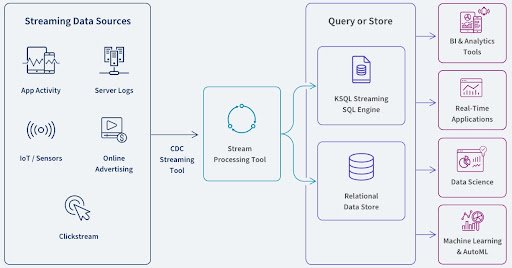
Leverage real-time data streaming tools, and here are the three popular options:
- Flow by Estuary: Collect, store, and process data in real time from multiple sources. The data are materialized in a wide variety of formats.
- Google Cloud DataFlow: Offer ready-to-use Artificial Intelligence (AI) patterns. It helps you build smart solutions like predictive analytics, anomaly detection, and other advanced analytics.
- Apache Kafka: A built-in event streaming system consisting of servers and clients communicating through a high-performance TCP network protocol.
It's also crucial to share information with the stakeholders. It provides an opportunity to have meaningful communication with them. At the same time, stakeholders can contribute their expertise to the decision-making process.
Supply chain analytics software (SAP, Microsoft Power BI, etc.) happens to provide this solution. It gives access to essential data from various sources and applications associated with the supply chain processes. You can also consider using ERP and Cloud Product Lifecycle Management software. They are ideal for better inventory planning, traceability, and visibility.
2. Improvements via IoT Deployments
IoT, or the Internet of Things, is imperative for solving problems and improving all areas of the supply chain processes. Starting from your data and processes, you can implement an IoT platform to create a single, central system. It maximizes supply chain efficiency and centralizes visibility. Let's now focus on supply chain management and logistics.
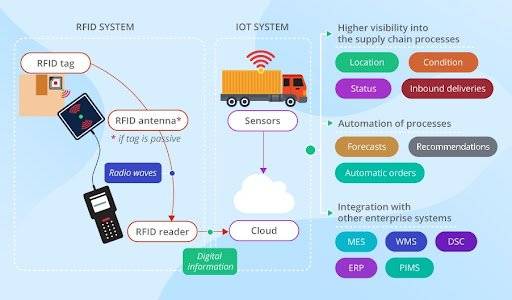
Supply chain management refers to all activities related to creating and delivering quality products to customers. On the other hand, logistics focuses on efficiently storing and moving the finished goods and services from one location to another. It also ensures that the goods have space at their intended distribution center.
Business leaders experience disruptions regularly and one that has the biggest impact on supply chains is delays. Deploying IoT solutions to supply chain management and logistics can help prevent costly delays and achieve customer satisfaction. Here are the areas where you can deploy IoT solutions:
- Transportation: Install IoT-based track and trace devices for real-time monitoring. It also helps drivers to find the easiest and shortest routes available.
- Warehouse management: Deploy IoT devices (sensors, scanners, etc.) to update order fulfillment and availability automatically. They can also automate processes to save more time.
- Inventory management: Train the machine learning model from the recurring patterns in your IoT device data to optimize the processes. A good example is determining the most appropriate time to schedule delivery and estimate the arrival times in the warehouse. All are in consideration of time, urgency, and other elements.
Did you know that IoT solutions can also eliminate the causes of food waste? With the help of IoTs, agricultural sectors and food manufacturers can access food safety data. The data may range from optimal storage conditions to identifying pathogens.
Let's say you are manufacturing quality ingredients for agricultural products. The IoT can help you identify chemical and biochemical reactions at every process stage: harvest, production, and transportation. You can also program them to observe safety regulations and processes, like Hazard Analysis Critical Control Points (HACCP). Once it detects contamination, it will alert your staff for inspection.
3. Adopt Smart Warehouse Technologies
Previously, we have discussed IoT applications in warehouse management. But there are more modern technologies to improve the efficiency and sustainability of logistics. The key to ensuring success is choosing the right combination of technology. Implement it right to create a highly productive smart warehouse operation.
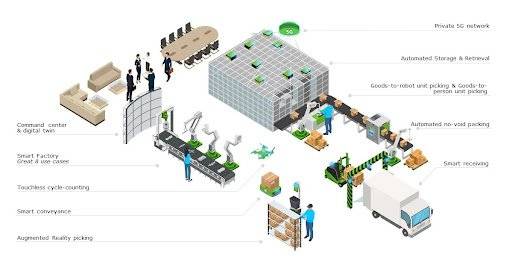
Automation is one of the favorite IoT and AI-enabled tools in intelligent warehouses. IoT works by connecting one or more devices to a network. While artificial intelligence works by programming tasks and processes to operate automatically and reduce manual intervention. There are different types of automation: basic and process.
The basic automation is set to streamline and unify routine tasks. It speeds up the tasks' processing times with little to no human intervention. Data gathering, stock monitoring, and inventory control are common routine tasks for basic automation.
Process automation can also automate repetitive tasks with much more complex processes. This kind of task usually consists of multi-step processes and requires integrating with different systems/software before you can automate them. You can implement process automation on inventory, order management, and shipping. Customers demand a shorter lead time, so automating these areas is highly beneficial.
For instance, if you are running an eCommerce website for single and multi-person stand-up paddle boards. Managing massive volumes of products daily would be much easier if you automate the following tasks:
- Product release: Schedule publishing of new paddle boards, gears, and accessories.
- High-risks orders: Automate fraud detection check to alert the security team when it detects fraudulent activities.
- Order fulfillment: Send the customer a notification when their purchased paddle boards are packed and ready to ship.
- Low inventory level: Auto-removal of out-of-stock products and email the production team for replenishment. Some business owners never remove the item from the store webpage. They will change the ‘Add to cart’ button to ‘Notify me when available’ and place a ‘sold out’ label.

4. Digital Workforce
Using IoT and artificial intelligence technologies in the supply chain helps build an intelligent working environment. It enhances operational efficiency and security while minimizing the risks of error. You can further improve it using machine learning and robotic technologies.
These advanced technologies are the perfect combination to build a digital workforce. You can create 3 kinds of digital workers: chatbots, bots, and robotics.
4.1 Chatbots
As the name implies, the chatbot is an automated computer program that can simulate a human conversation. It can efficiently do so because it uses AI, machine learning, and natural language processing. The AI also allows processing and simulating chat conversations through text or text-to-speech.
Customers expect businesses to answer their questions fast. That is why chatbots are often used in business websites as Tier-1 customer service representatives. You can program the chatbot to answer product/order-related and frequently asked questions. Take Anytime Baseball Supply, a pitching machine and baseball equipment retailer.
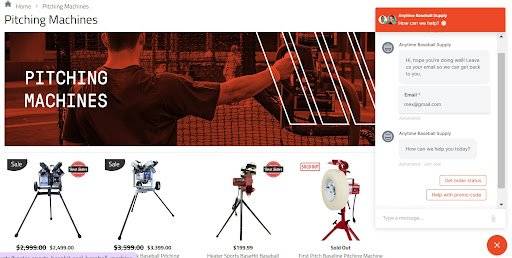
They use the chatbot to give customers updates on their order status. They also extend help if your promo code doesn't work. Chatbots understand basic questions. It will generate a response based on the information it encountered in the past. You can make it more interactive by feeding more data. Here are the 3 popular functions you can train it for:
- Lead generation
- Make real-time reservations
- Communicate in different languages
4.2 Bots
Are a bot and a chatbot the same thing? Some use these two interchangeably, but they are different from each other. The bot is rule-based, which means it only follows the conversational rules set by its creator. It may not work as well as chatbots, but it is as effective in simulating human activity. That is why it is popularly used to create software applications.
The bot's primary function is automating tasks. But you can expand its functionalities by adding advanced technologies. An email bot is one good example.
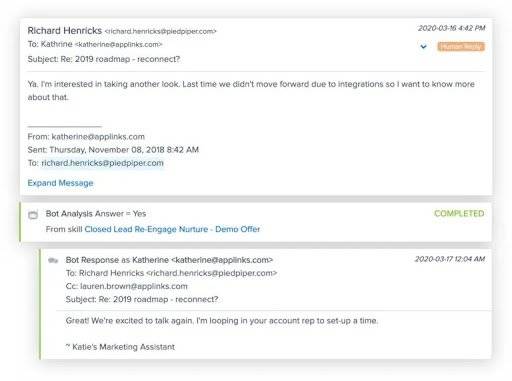
After you find email addresses and verify them, the email bot can take care of the rest of the process. AI and contextual analysis provide instant and customized responses to potential leads. It ensures the potential lead will receive the right message. Some also add machine learning to help interpret the email message and decide the best course of action to offer.
Offering the most competitive prices in the market is vital in building customer loyalty. You can build a bot like Shopbot to find the best prices for a product online. Transform it into a full-fledged application to get the complete package. You can add repricing technology and automation to get it to function for:
- Instant Repricing
- Price comparison
- Revenue Analytics
- Basic and advanced repricing
- Auto-adjustment of the product price
When building a software application like this, consider the platform you will use it for. Let's say it is for Amazon. You have to create the repricing tool for Amazon FBA sellers to guarantee the accuracy rate.
4.3 Robotics
Labor shortages are a supply chain disruption that heavily impacts businesses today. However, the rapid development in robotics gives a promising future to fill the labor gap. Robotics is by far the most advanced technology in the supply chain industry. Most of it is designed to work side-by-side with human employees, performing repetitive tasks. It is popularly known as collaborative robots or cobots.
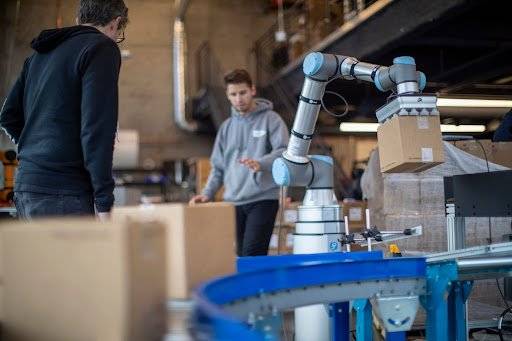
The screenshot above is an example of a universal robot. It is a cobot arm that can help lift heavy items and perform process-intensive tasks (welding, packaging, etc.). It is commonly used in manufacturing solar panels and renewable products. It possesses incredible dexterity, flexibility, and precision that can reliably produce ingots, solar cells, and modules at very high speeds.
Other robots are built as driverless vehicles to perform tasks without human control. Amazon uses a combination of these cobots, and as of today, Amazon has 520,000 robotic drive units. Here's how they use it:
- Shipping: Sorting packages
- Inventory: Scan inventory to check pricing and total count
- Warehouse: Collect and carry items for orders and check stock quantities
When it comes to delivery, self-driving trucks are the technology they offer. It is not widely available yet, but it promises to bring numerous benefits. Some of these promises are:
- Improve road safety
- Lowers carbon emissions
- Cost-effectiveness (reduces fuel and labor costs)
5. Security
SMBs face various challenges in the digital world. One that has the most negative impact lies in security. Cyber crimes are rising, and the cost of damage is predicted to reach $8 trillion this year. Since SMBs are easy targets for cyber-criminals, you should equip your organization with a reliable security solution.
The good news is that there are plenty of security solutions to choose from, each solving different types of security threats. Here are 2 popular threats that can cause significant disruptions:
5.1 Fraud
The supply chain comprises a large community of resellers, distributors, partners, and other third-party networks. Each party provides a unique set of policies, ethical codes, and systems. Some organizations have difficulty taking everything into account, which ends up having weak internal control. This gives people (business partners) an opportunity to strike and commit fraud.
Most frauds committed are bribery during the selection process of suppliers and kickbacks. You can protect the organization by creating your own policies for bidding and contract negotiations. Fraud is not only committed by an external party; it could also be your employees (theft).
If you suffer from this type of fraud, implement barcode technology. It will give you close monitoring of inventory and assets across the supply chain.
5.2 Data Breaches
Data is the most valuable asset of businesses. If it gets stolen you can end up losing significant revenue. The most common type of data breach is phishing attacks. Cybercriminals will create an exact copy (or better) of the website they want to use and pretend to be a reputable company representative. They usually send it via email.

The payment gateway is usually the website they mirror. Once you click the fraudulent link and log into your account, you will give the cybercriminals your password and other sensitive details. Learning to spot a phishing message is the manual method to protect your organization against phishing.
Phishing messages include threats to persuade you to take immediate action. Upon seeing this, it's best to pause and ask, 'Is it the first time I have received an email from the specified sender?' If yes, check every aspect of the message.
- Email domain: Legitimate businesses have a personalized domain (timedoctor.com or microsoft.com). It is a scam if it ends with Gmail or a misspelled domain name.
- Suspicious attachment or link: Hover your mouse over the link or attachment and see the web address. It is a scam if it's not the company's web address.
- Bad grammar: Businesses always send personalized greetings and professional content. It is a clear sign that the message is a scam if it addresses you with 'Sir' or 'Madam' and plenty of grammatical errors in the content.
When you receive a phishing email, report it immediately and delete it. Some email providers offer threat protection. You can purchase it to help protect your employees. Other threats you may encounter are listed as follows:
- Ransomware
- Malware or virus
- Recording keystrokes
- Distributed Denial of Service (DDoS)
Get The best antivirus software, but you can also try breach detection systems. It may be a relatively new security system, but it's proven to protect the supply chain's operational data.
Conclusion
The impact of technology on the supply chain industry will only get stronger in the upcoming years. New advancements are soon to release, strengthening production workflow efficiency, identifying risk issues, and more. It is best to continuously assess your supply chain challenges and overall operation so that you will know the right technology to implement.
The guide above can help you select the technology based on its purposes and how it fits across the supply chain areas. But you can also choose digital tools that greatly impact your business growth. For example, investing in mobile applications is innovative because it provides a better overview of the supply chain network. It also offers accessibility to updates, data, and key reports.
Sending valuable goods around the world requires a trusted shipping platform. SeaRates can make your local and international trading as smooth as possible. We provide agile solutions for all your supply chain needs, regardless of your operation size or sales volume. Check out our website to learn more about our services and what we can offer you.

